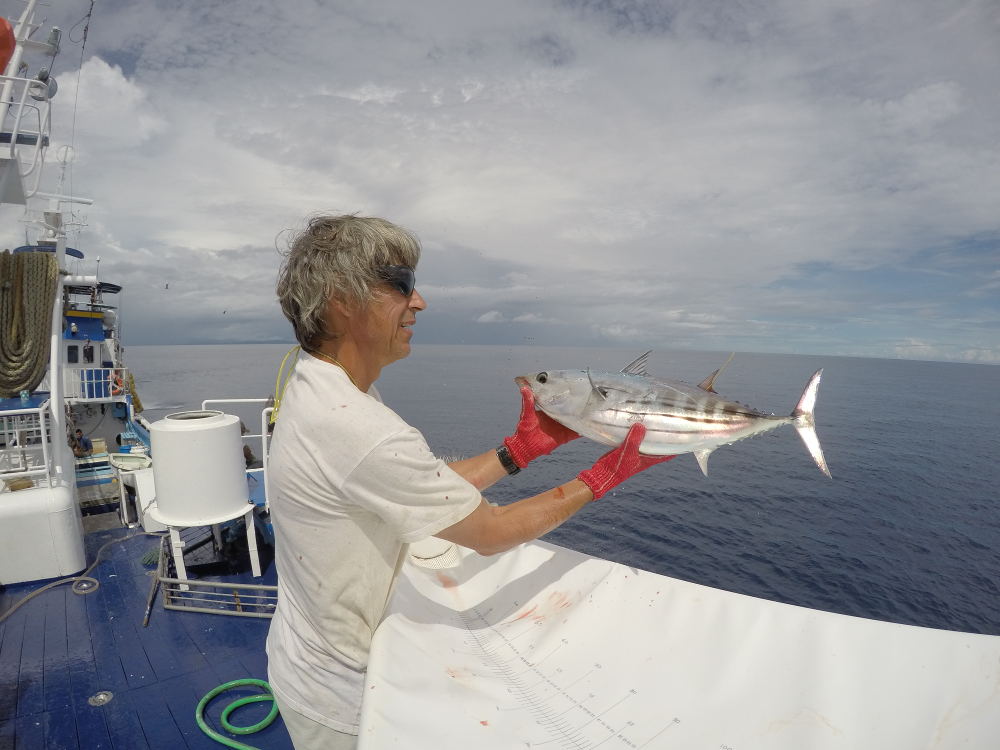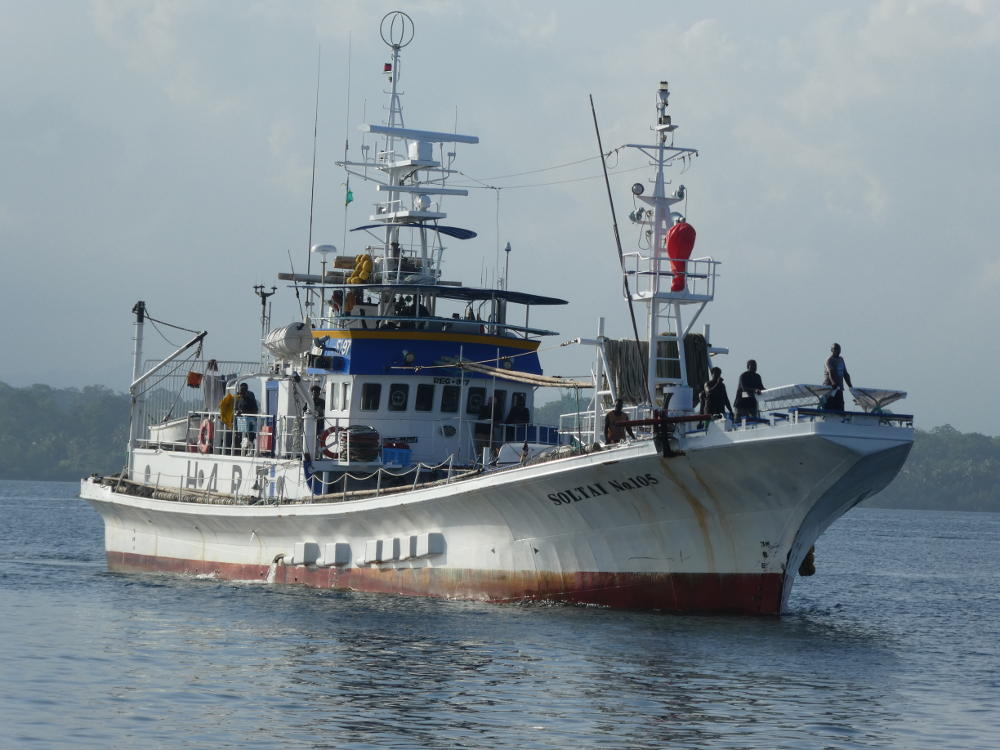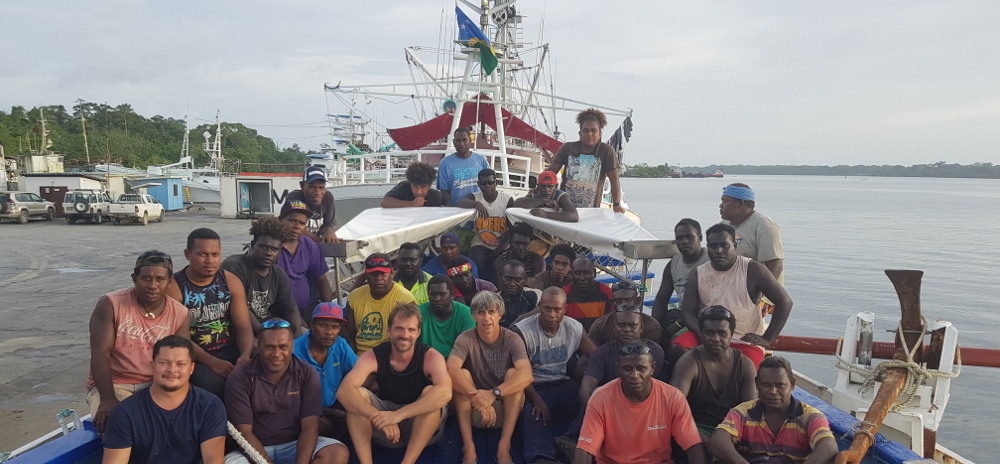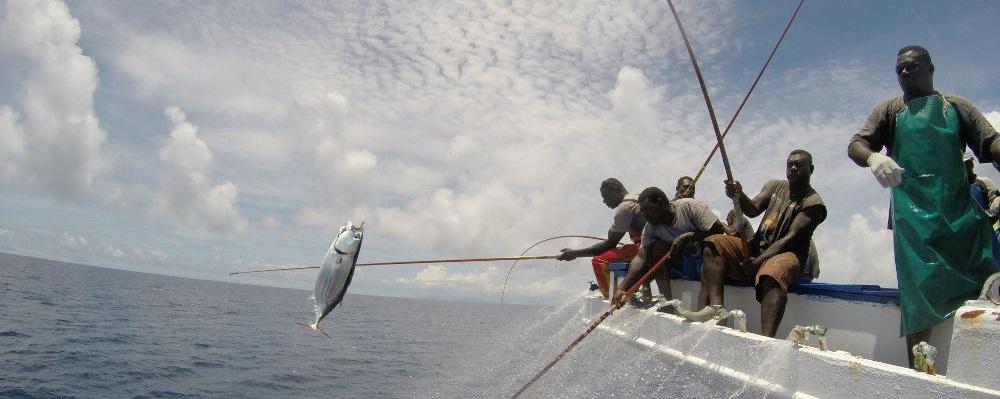Poling a skipjack at the bow
Tuna fisheries in the Pacific Ocean is a global business that generates billions of dollars each year, employs millions of people and provides sustenance to millions more.
SPC’s Oceanic Fisheries Programme has recently completed a successful tuna tagging voyage, releasing almost 28,000 tagged tuna into the Pacific Ocean. As these tags are gradually recovered, the data collected will contribute to our understanding of the health of tuna fisheries in the Pacific by monitoring mortality, movement and growth of tagged fish. This information provides critical population parameters that are then used to estimate the health of tuna stocks, and the impact of fishing practices.
Tuna fisheries have expanded in the Pacific over the past three decades, and the region now produces over 60% of the world’s tuna. The most critical fishing activities are the industrial scale purse seine, longline and pole-and-line fisheries, but large catches are also made by smaller fishing vessels. However, threats such as overfishing and climate change put this vital natural resource at risk.
The Western and Central Pacific Fisheries Commission (WCPFC) is responsible for setting sustainable management practices and conservation measures of highly migratory fish stocks (tunas and billfish) throughout the region. Data must be collected to improve our knowledge about the biology of tuna species and better assess the fishing impact on their populations to allow the WCPFC to make management decisions. An important part of this data is collected from SPC’s tagging voyages.

In September 2017, SPC’s Oceanic Fisheries Programme embarked on a 2 month long tagging voyage in the waters of PNG and Solomon Islands, led by Bruno Leroy, Fisheries Scientist. The voyage is part of the Pacific Tuna Tagging Programme, a WPCFC project being implemented by SPC. Beginning in 2006, it is the largest tuna tagging project ever implemented in the world.
During the recent voyage, tagging technicians placed small plastic tags, called conventional tags, on the tuna. The fish are caught using the pole-and-line fishing method. This allows the fish to be caught, measured, tagged and released in just a few seconds. Information on each tagged individual including species, length, fish condition and tagging quality is recorded using voice recorders.
During the tagging process, scientists will also collect biological data on the tuna and bycatch species such as mahi-mahi, rainbow-runner, and wahoo that are too injured to be released. This collection includes samples of gonad, liver, stomach, otolith, muscle and dorsal spine. All these samples are kept frozen, to be sent to SPC’s tuna tissue bank in Noumea, New Caledonia. These biological samples will help provide greater knowledge of tunas and bycatch biology, improving the assessment of the status of the Pacific tuna stocks.

The team on SPC’s most recent tagging voyage endured challenging conditions as they searched for schools of tuna in the Western Pacific ocean. After some initial delays as the team navigated the complicated bureaucracy of obtaining permits and visas for research across the Exclusive Economic Zones (EEZ) of multiple countries, the team set off for its first destination, Noro in the Western Province of Solomon Islands.This little town is in fact one of the most active tuna fishing ports of the Pacific Islands and the home base for FV Soltai 105, the 37 meter pole and line vessel that SPC chartered to implement this tuna tagging experiment. Since 2008 (an older vessel of the same company was chartered in 2006 and 2007) this vessel and her 30 crew members, all Solomon islanders, have assisted SPC scientists for releasing about 300,000 tagged tunas all over the Western and Central Pacific Ocean.
As the voyage moved on to the Papua New Guinea EEZ, the vessel fished near anchored Fish Aggregating Devices (FADs), a tactic that was sometimes successful but also risked delays if FADs were missing. Even if the FAD was in place, there was no guarantee that any target species would be present. The team also tracked the movement of bird flocks as a way to locate free schools of tuna nearby.
Some days, despite hours of gruelling work in challenging conditions, not a single fish was tagged. Others, the team were able to tag thousands of fish in a single day. Each tagging technician may tag hundreds of fish in a day, or none at all, often working in rough seas, high winds and heavy rain. Some schools contained large individuals over 60cm in length. These fish are hard to work with, and their powerful tails can bruise and scratch the fishers as they are captured for tagging.
Tagging voyages require patience, grit and commitment from the crew and scientists living and working in cramped conditions on board. They could spend days chasing elusive schools of tuna, only to lose them at the last moment. Other days, good luck and good planning combined to allow technicians to release thousands of tags into the ocean.
Now that the crew have finished the hard work of releasing the tags, Caroline Sanchez, Senior Fisheries Technician and Tag Recovery Co-ordinator, will begin the task of collecting and analysing data from tags as they are recovered by fishers throughout the region. Tags can be recovered over a vast swathe of ocean from Thailand to Ecuador and beyond, and the recovery of tags is a time consuming, long term process.
When fishers find a tagged tuna, they will receive a reward payment if they return the tag along with information about the date and location of recapture and size of the fish back to SPC. These data provide critical indications about fishing mortality, natural mortality, movements and growth. These are all important population parameters that are used to estimate the health of tuna stocks.
The goal of the voyage was to tag 20,000 tuna in the EEZ of PNG and Solomon Islands. With 27,780 releases, the voyage was a resounding success, with a record breaking release of tags in the Solomon Islands EEZ. The cruise also allowed the training of new tagging technicians and undertook extensive biological sampling that will help build our understanding of the ongoing health of tuna stocks in the face of intensive fishing activities and a changing climate.The data collected from the tags over next months and years will help increase our understanding of tuna fisheries, and the impact of fishing activities on tuna fisheries throughout the Pacific. SPC’s latest record breaking tagging voyage will help inform future sustainable management decisions that will help protect tuna stocks and the people who rely on them.

